서 론
육계의 장내 미생물 균총은 소화장관 전체에 걸쳐 형성되며, 건강을 유지하고 사육 생산성에 중대한 영향을 미치는 핵심 요소이다(Deryabin et al., 2024). 이러한 장내 미생물은 사료 소화 및 영양소 흡수에 기여하며 면역 체계를 발달시키고 병원성 박테리아의 증식을 억제함으로써 전반적인 장 건강에 크게 기여한다(Zhou et al., 2021; Al Hakeem et al., 2023). 연구에 따르면, 육계의 미생물 균총은 식단, 유전학, 지리적 위치, 주거 시스템, 환경 조건과 같은 다양한 요인에 의해 영향을 받는다(Kers et al., 2018; Diaz-Sanchez et al., 2019; de Jong et al., 2022). 특히 계절과 관련된 환경 변화, 주거 시스템과 같은 외부 환경은 초기 육계의 장내 미생물 균총 구성에 중요한 영향을 미치는 것으로 알려져 있다(Oakley et al., 2018; Dai et al., 2021; Zhou et al., 2021). 또한, 이러한 외부 요인은 장내 미생물 균총의 불균형을 유발할 수 있다(Shi et al., 2019; Liu et al., 2023). 이로 인해 면역 체계 손상과 병원성 박테리아 증가에 의한 질병이 유발될 수 있고 성장 성능 또한 저하될 수 있다(Ducatelle et al., 2018; Carrasco et al., 2019; Aruwa et al., 2021). 따라서, 주변 사육 환경이 육계의 장내 미생물에 미치는 영향에 대한 연구가 필요한 실정이다.
가금류는 체온 유지를 위한 땀샘이 부족하여 고온에 매우 취약하기 때문에 여름철 고온 환경은 육계 생산에서 가장 유해한 환경 스트레스 요인 중 하나이며 매년 농가에 큰 경제적 손실을 초래한다(Mohammed et al., 2018; Liu et al., 2019; Mayourga et al., 2019). 이러한 고온 환경은 사료 섭취량 감소, 사료 효율 저하와 같은 육계의 성장 성능을 저하시킬 뿐만 아니라 미생물 균총 형성에도 부정적인 영향을 끼치는 것으로 보고되었다(Chauhan et al., 2021; He et al., 2021; Liu et al., 2022). 또한, 고온 환경으로 인한 육계의 스트레스는 장의 장벽을 파괴하여 형태학적 손상과 기능 장애를 유발하는 것으로 나타났으며, 이는 세균성 박테리아에 대한 장내 투과성을 증가시키고 미생물 다양성을 감소시켜 장내 미생물 균총의 불균형을 초래하는 것으로 나타났다(Burkholder et al., 2008; Shi et al., 2019).
더욱이, 사육 밀도도 육계의 장내 미생물 균총 구성에 영향을 주는 것으로 여러 연구를 통해 밝혀졌다(Cengiz et al., 2019; Liu et al., 2023). Cengiz et al.(2019) 은 20수/m2의 고밀도에서 사육된 육계가 14수/m2에서 사육된 육계와 비교해 사료 효율 향상에 중요한 역할을 하는 Lactobacillus의 풍부도가 감소했다고 보고했다. 또한, Liu et al.(2023)은 22수/m2의 고밀도가 14수/m2의 정상 밀도와 비교해 장의 형태학적 손상, 산화스트레스 및 장 면역 시스템의 문제를 유발하여 공장 내 미생물의 다양성이 저하되고 병원성 박테리아에 속하는 Turicibacter 및 Shigella의 풍부도가 증가한다고 보고했다. 이러한 배경으로, 본 연구에서는 농가 간 사육 밀도와 계절에 따른 온도 차이가 육계의 장내 미생물 균총의 변화를 유도할 것으로 판단했다. 현재 사육밀도에 대한 한국의 동물복지 육계 농장 인증 기준은 19수/m2이다. 따라서 본 연구는 한국의 동물 복지 인증을 받은 농가와 일반 농가에서 봄과 여름철 육계의 장내 미생물 균총을 비교 분석하였다.
재료 및 방법
본 연구는 농촌진흥청 국립축산과학원의 동물실험 계획서에 의거 동물보호법 및 국립축산과학원의 동물시험윤리위원회에서 승인된 동물실험방법(승인번호: 2021-0508)에 따라 수행함.
본 연구는 전라북도 장수군에 위치한 30만수 규모의 육계 평사 사육 일반 농가와 전라남도 보성에 위치한 18만수 규모의 동물복지 인증을 받은 농가를 선정하여 연구를 수행하였다.
육계 일반 농가의 사육밀도는 20.3수/m2이며 복지 농가의 사육밀도는 18.9수/m2로 조사되었다. 모든 농가는 무창계사와 강제환기(터널식)로 봄철 평균기온은 26.2℃이며 여름철 평균기온은 31℃로 조사되었다.
부화 후 19일령 육계(Ross 308)의 체중을 측정하였다. 중앙 체중에 가까운 7∼8수를 선발하여 CO2로 안락사 시킨 후 맹장 소화액을 채취하여 액체 질소에 침냉한 후 초저온 냉동고(−80°C)에 보관하였다. 16개(봄철 복지농가 샘플 1개 제외)의 육계 맹장 샘플에서 메타게놈 분석 DNA를 비드 비팅 플러스 컬럼(RBB+C) 방법을 사용하여 추출하였다(Yu and Morrison, 2004). Illumina 16S Metagenomics Sequencing Library 프로토콜에 의해, sequencing library는 V3 및 V4 영역 사이에서 증폭하기 위해 준비하였다. 추출한 DNA은 16S rRNA 유전자 염기서열 분석을 통해 농가별 계절변화에 따른 박테리아 구성 변화를 분석하였다(Kim et al., 2020). Paired-end(2 × 300 bp) sequencing은 MiSeq platform(Illumina, San Diego, CA, USA)을 사용하여 Macrogen에서 실시하였다. 341F(5’-CCTACGGGNGGCWGCAG-3’) 및 805R(5’-GACTA CHVGGGTATCTAATCC-3’) 프라이머(Herlemann et al., 2011)를 사용하여 앰플리콘 서열은 Quantitative Insights into Microbial Ecology 버전 2(QIIME2) (Bolyen et al., 2019)에 구현된 DADA2 파이프라인(Callahan et al., 2016)을 사용하여 처리하였다. 앰플리콘 서열 변이(ASV)는 최신 Silva 데이터베이스(NR 138 버전)에서 훈련된 나이브 베이즈 분류기를 사용해 분류학적으로 분류하였다(Quast et al., 2013). 알파 다양성 지수를 계산하여 계절에 따른 농가별 샘플 간의 풍부성, 균등성, 계통학적 다양성 차이를 분석하였다. 농가별 샘플 간의 전체 분포는 principal coordinate analysis(PCoA)을 사용하여 조사하였다. 미생물 군집 데이터를 비교, 분석하기 위해 QIIME2 emperor plugin을 사용하여 시각화 하였다(Vázquez-Baeza et al., 2013). 미생물 군집의 다양성과 균일성을 확인하기 위해 Shannon 지수와 Simpson 지수, Chao1 지수를 통해 알파 다양성을 확인하였다. 육계 장내 미생물의 조성변화에 미치는 영향을 확인하기 위해 Linear discriminant analysis Effect size(LEfSe) (http://galaxy.biobakery.org/)를 실행하여 linear discriminant analysis(LDA) score를 확인하였다. LEfSe 분석은 default 값인 Kruskal-Wallis 유의수준 0.05, Wilcoxon test 유의수준 0.05, LDA>2.0으로 분석이 수행되었다.
육계 미생물군에서 상대적 풍부도가 0.5% 이상인 주요 분류군을 평가하였다. 주요 분류군 간 풍부도 차이를 평가하기 위해 QIIME2(Mandal et al., 2015) 구현된 마이크로바이옴 구성 분석(ANCOM) 플러그인을 사용하였다. 박테리아 커뮤니티 간의 차이를 분석하기 위해 PAST3 소프트웨어를 사용하여 순열 다변량 분산 분석(PERMANOVA)을 수행하였다.
결과 및 고찰
계절 간 육계의 맹장 내 미생물 군집 풍부도 및 다양성 변화를 분석하기 위해 ACE, Chao1, Shannon 및 Simpson 지수를 사용하여 Alpha 다양성 분석을 실시하였다(Fig. 1). 분석 결과, 봄과 여름철 계절 차이는 맹장 내 미생물 군집 풍부도 및 다양성에서 유의미한 차이를 보이지 않았다(Fig. 1). 우리의 결과와 유사하게 26°C와 32°C 환경에서 육계의 맹장 내 미생물을 비교 분석한 연구에서도 Chao1, Shannon 및 Simpson 지수를 포함한 Alpha 다양성은 유의미한 차이를 보이지 않았다(Liu et al., 2021a). 또한, 21.3°C와 32.5°C 환경에서 육계의 회장 내 미생물을 비교․분석한 연구에서도 ACE, Chao1, Shannon 및 Simpson 지수를 포함한 Alpha 다양성은 유의미한 차이를 보이지 않았다.
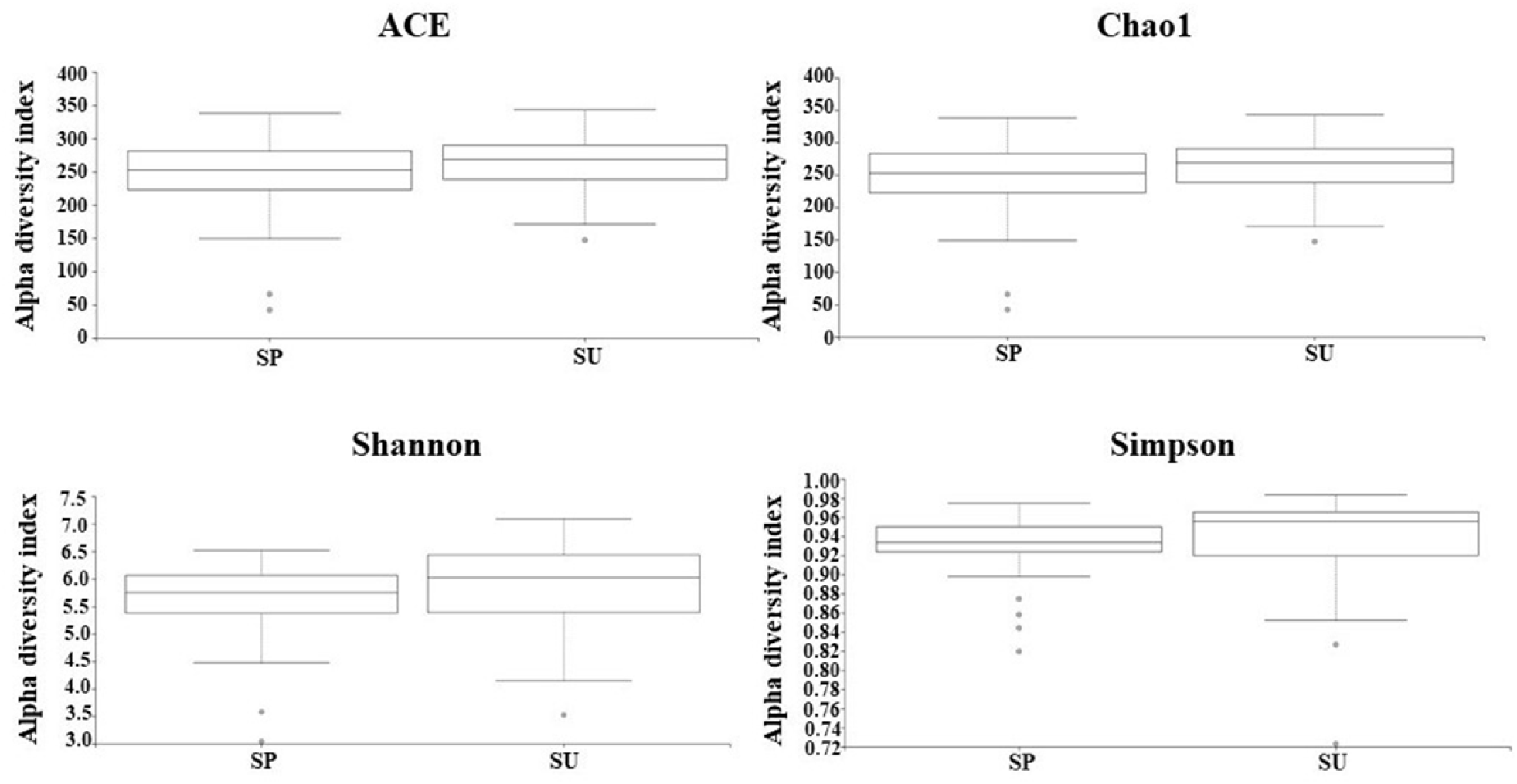
계절 간 일반 농가와 복지 농가 육계의 맹장 내 미생물 조성 차이를 분석하기 위해 Beta diversity 분석을 수행하였다. Beta diversity 분석은 Jaccard distance을 기반으로 한 PCoA를 적용하여 수행되었다. 분석 결과, 일반 농가(P=0.017)와 복지 농가(P=0.001) 모두에서 맹장 내 미생물 구성에 있어 차이가 관찰되었다(Fig. 2). 이 결과는 사육환경에서의 온도에 따라 육계의 맹장 미생물 균총 다양성에 차이를 보인 것으로 판단되며, 이전 연구들과 유사하다(Mohd Shaufi et al., 2015; Wang et al., 2018; Shi et al., 2019). 육계의 소화기관은 고온 스트레스의 주요 표적 장기로 간주되며, 고온은 육계 소화장관의 형태학적 손상 및 장 점막의 산화환원 상태 불균형을 초래한다(Zhang et al., 2017; Liu et al., 2020; Chauhan et al., 2021). 이는 세균성 박테리아의 장 투과성을 향상시켜 장 기능 장애로 이어지고, 결국 장내 미생물 균총에 부정적인 영향을 미친다(Rostagno et al., 2020; Wang et al., 2020). 따라서, 본 연구에서 봄철과 여름철 장내 미생물 구성의 차이는 고온 스트레스로 인한 장내 미생물 균총 불균형에 기인한 것으로 판단된다.
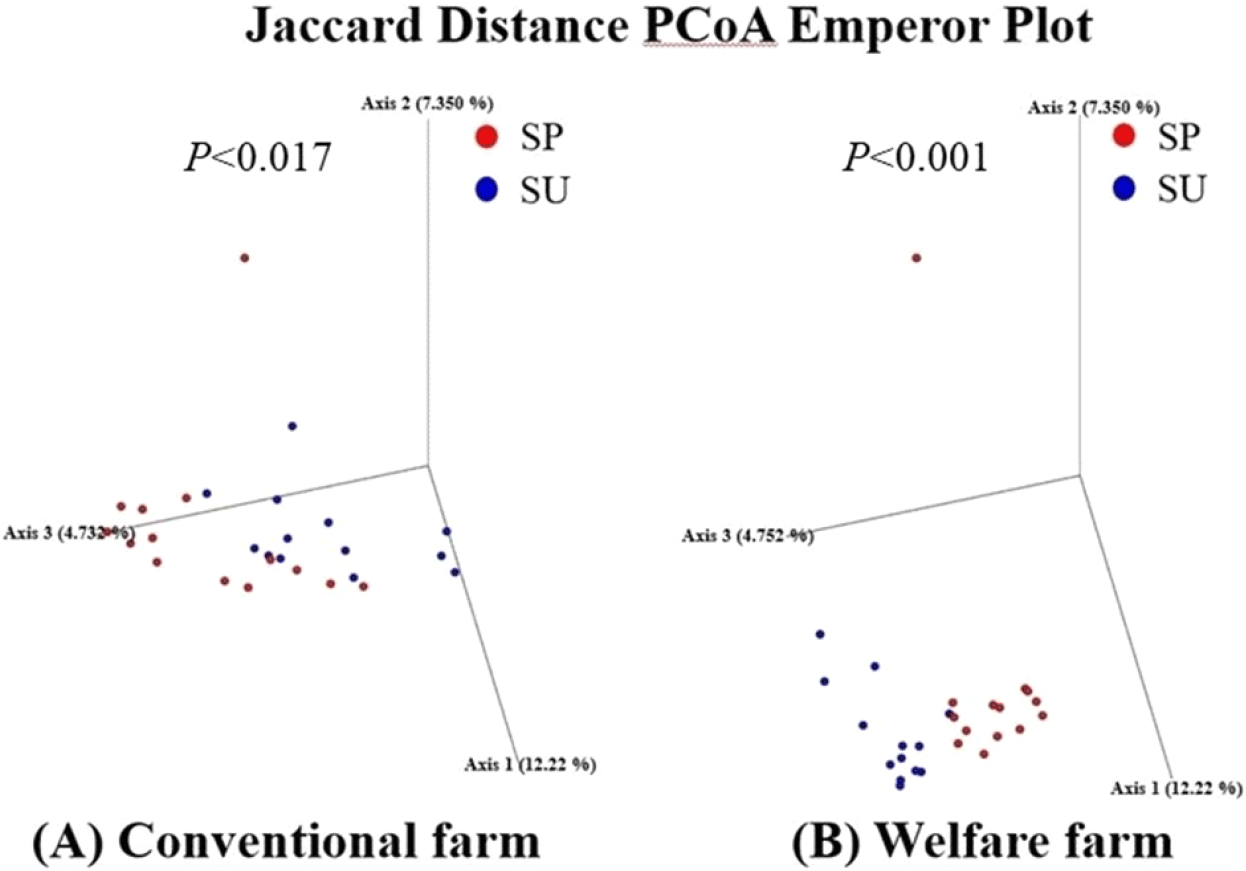
일반 농가에서 육계의 맹장 내 미생물 균총 분포를 문 수준에서 분석한 결과를 Fig. 3A에 나타냈다. 분석 결과 봄철과 여름철 모두에서 Firmicutes 및 Bacteroidota가 우점하는 경향을 보였으며, 이는 선행 연구 결과들과 일치한다(Mohd Shaufi et al., 2015; Adewole et al., 2021). 또한, 속 수준에서 분석한 결과를 Fig. 3B에 나타내었다. 분석 결과 봄철과 여름철 모두 Faecalibacterium가 가장 우점하는 것으로 나타났다. Faecalibacterium은 일반적으로 가금류의 미생물 군집에서 가장 지배적인 속이다(Wang et al., 2016; Kairmi et al., 2024).
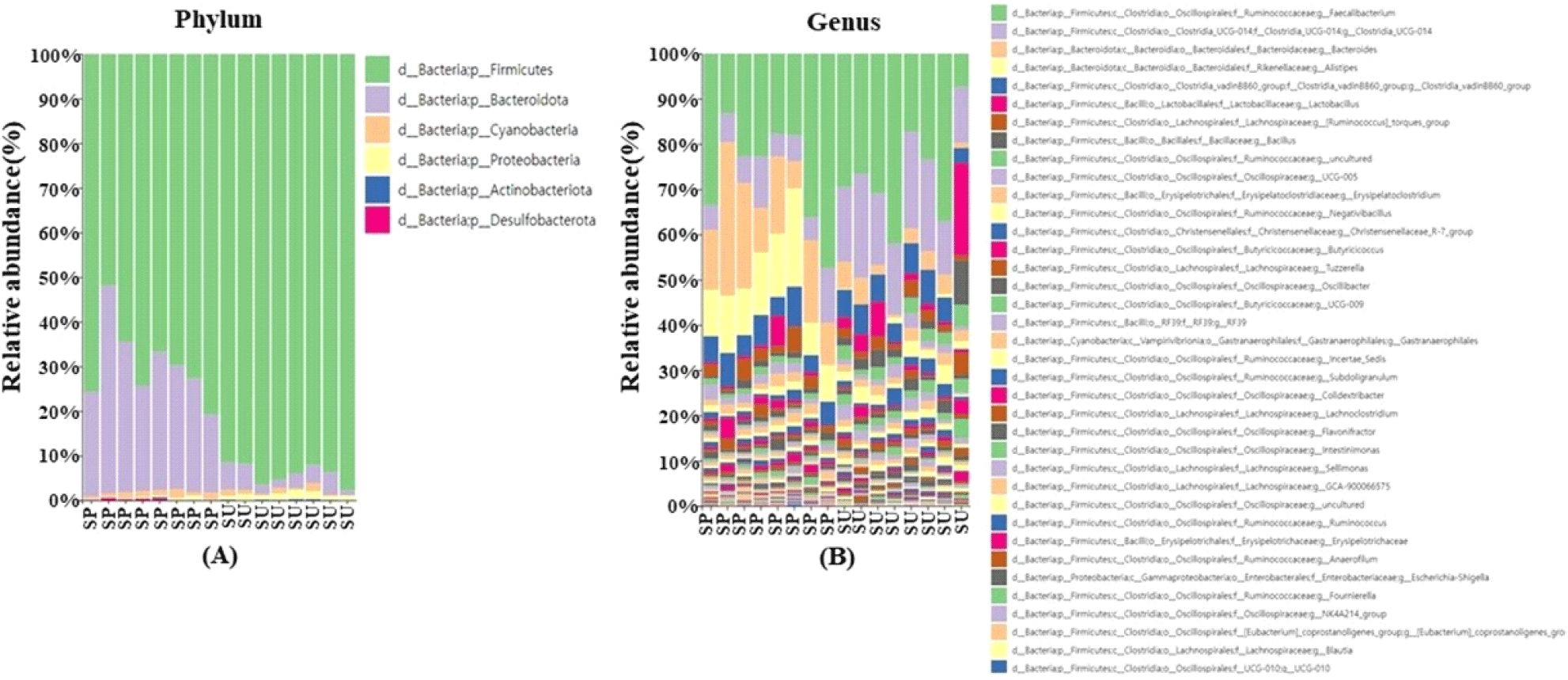
계절 간 차등적으로 풍부한 분류군을 가지는 장내 미생물을 확인하기 위해 LEfSe 분석을 실시하였고, 문 수준에서, 여름철에는 Firmicutes의 비율이 봄철과 비교해 높은 풍부도를 보였으나, Bacteroidota의 비율은 여름철이 봄철과 비교해 낮은 풍부도를 보였다(Fig. 4). Bacteroidota는 다당류를 단쇄지방산(short chain fatty acid, SCFA)으로 발효시켜 숙주에게 영양분을 제공하고 장내 미생물의 안정성을 유지할 수 있다 (Ndeh et al., 2018; Hao et al., 2021). 그러나 Liu et al. (2023)에 따르면, 31.1°C의 고온 환경에 노출된 육계는 맹장내 Bacteroidota의 풍부도가 감소했다고 보고되었으며, 우리의 결과와 유사하다. Firmicutes는 장내에서 숙주가 소화할 수 없는 다당류를 분해하여 신체의 영양소 소화 및 흡수 촉진을 통해 성장에 긍정적인 영향을 미치는 것으로 알려져 있다(Lozupone et al., 2012; Johnson et al., 2017). 본 연구에서는 봄철과 비교해 여름철에 Firmicutes가 풍부함에도 불구하고 성장 성능에 유의미한 차이를 보이지 않았는데, 이는 장내 미생물 균총 변화로부터 얻게 되는 에너지 생산량 증가보다 더운 날씨에 적응하기 위해 소모하는 에너지와 고온 스트레스로 인한 에너지 손실이 더 클 수 있기 때문으로 사료된다. 속 수준에서 LEfSe 분석 결과에 따르면 봄철에는 Bacteroides와 Alistipes의 비율이 여름철과 비교해 높은 풍부도를 보였다(Fig. 4). 육계에서 Bacteroides는 장내 미생물 균총의 성장과 숙주의 포도당 항상성에 중요한 역할을 하는 것으로 알려져 있으며(Jumpertz et al., 2011), Alistipes는 숙주의 면역력과 질병 저항성을 개선하는 것으로 알려져 있다(Li et al., 2022). 또한, Bacteroides와 Alistipes 모두 SCFA를 생성하는 주된 미생물이며, 이는 결장 상피세포의 에너지원 역할을 하여 장 장벽 기능을 강화할 수 있다(Venegas et al., 2019; Song et al., 2023). 하지만 이전 연구에서 고온 스트레스는 유익속에 속하는 Bacteroides와 Alistipes의 풍부도를 감소시키는 것으로 나타났으며 본 연구 결과와 일치한다(Dayou et al., 2019; Yin et al., 2021). 대조적으로 Clostridia-UCG-014의 비율이 봄철과 비교해 높은 풍부도를 보였다. Clostridia-UCG-014는 박테리아 다양성과 장벽 기능에 긍정적인 연관이 있는 것으로 보고되었으나, 과도한 장내 Clostridia-UCG-014는 숙주의 무증상 괴사성 장염에 기여할 수 있다(Shanmugasundaram et al., 2021; Dai et al., 2023). 하지만 Clostridia-UCG-014가 육계 체내에서 미치는 명확한 기능과 역할에 대해서는 아직까지 구체적인 연구가 진행되어 있지 않아 추가적인 연구가 필요한 상태이다.
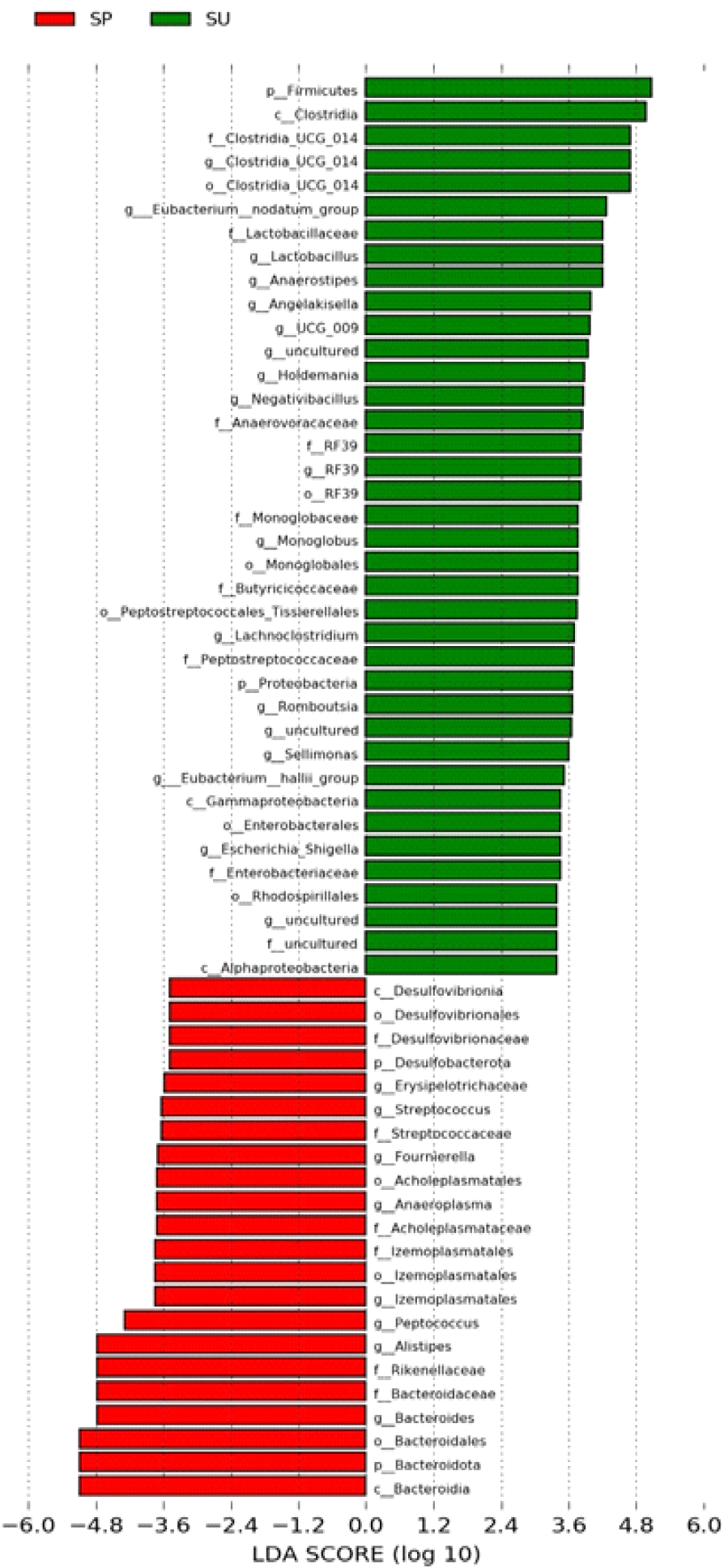
복지 농가에서 육계의 맹장내 미생물 균총 분포를 문 수준에서 분석한 결과를 Fig. 5A에 나타내었다. 분석 결과 일반 농가와 마찬가지로 봄철과 여름철 모두에서 Firmicutes와 Bacteroidota가 우점하였으나, 일반농가와 비교해서 계절에 따른 맹장 내 우점종의 균총 차이가 상대적으로 적은 것으로 판단되었다(Fig. 5A). 속 수준에서 분석한 결과 일반 농가와 마찬가지로 봄철과 여름철 모두에 Faecalibacterium가 가장 우점하는 것으로 나타났다(Fig. 5B).
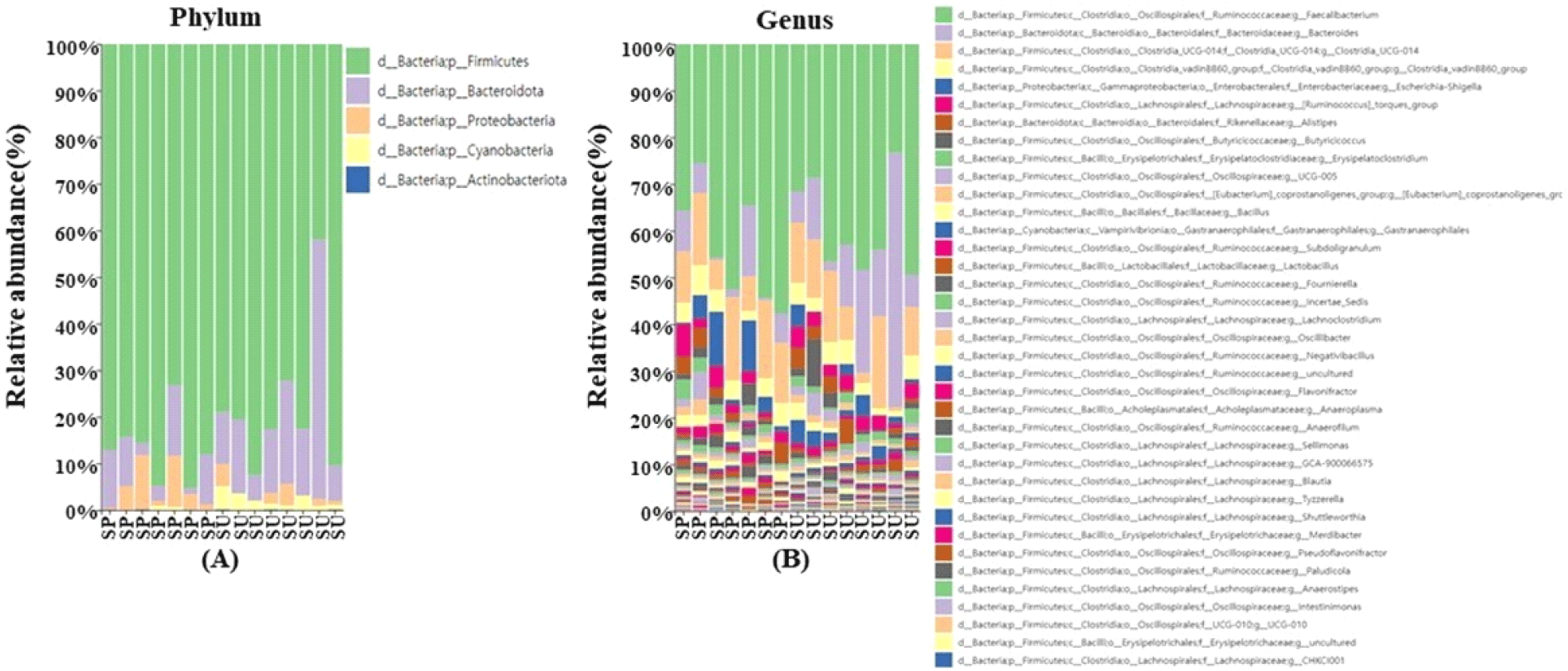
마찬가지로 복지 농가 육계 장내 미생물의 LEfSe 분석 결과, 일반 농가와 비교해서 계절에 따라 차이가 나는 장내 미생물 균총이 적은 결과를 확인하였다(Fig. 6). 육계의 장내 미생물 균총의 형성은 점진적으로 발달하여 대략 21일령에 안정화되는 것으로 알려져 있다(Zhou et al., 2021). 본 연구는 19일령 육계를 대상으로 미생물 분석을 수행하였으며, 따라서 본 연구에서 복지 농가의 육계는 일반 농가와 비교하여 상대적으로 장내미생물이 조기에 정착된 것으로 사료된다. 육계의 장내미생물 균총은 외부 환경 자극에 크게 의존하며 형성된다(Ding et al., 2017). 복지 농가는 일반적으로 육계에게 더 넓은 공간과 자연스러운 환경을 제공하며 이는 육계의 자연스러운 행동을 유도하여 미생물 군집 형성에 간접적으로 영향을 미치는 것으로 알려져 있다(Marcantonio et al., 2022). 또한, 복지 농가에서 사육된 육계는 일반적으로 스트레스가 저감되는 것으로 나타났으며 이는 면역 시스템의 긍정적인 영향을 미쳐 장내 미생물의 초기 정착에 기여할 수 있다(Yan et al., 2020; De Jong et al., 2022). 이와 같은 장내미생물의 초기 정착은 육계의 성장 성능과 건강은 물론 미생물 균일성에 긍정적인 영향을 미칠 수 있다(Sears, 2005; Stanly et al., 2013). 속 수준에서 LEfSe 분석 결과 또한, 일반 농가와 비교해서 계절에 따라 차이가 나타나는 장내 미생물 균총이 적은 것으로 확인되었다(Fig. 6). 하지만, 봄철과 비교해 상대적으로 고온 환경인 여름철에서 유익한 속에 속하는 Bacteroides가 LDA score 4.0 이상으로 확인되었다. 육계의 장내 미생물 균총은 고온 스트레스뿐만 아니라 식이, 유전적 배경 및 주거 환경 등 다양한 요인에 영향을 받을 수 있다(Oakley et al., 2018; Dai et al., 2021; Zhou et al., 2021). 따라서 본 연구 결과는 복지 농가에서 주거 환경의 개선이 육계 장내 미생물 군집의 초기 정착을 촉진하고, 여름철 고온 스트레스의 영향을 완화시킨 것으로 추정되나, 정확한 기전을 규명하기 위해서는 추가 연구가 필요할 것으로 판단된다.
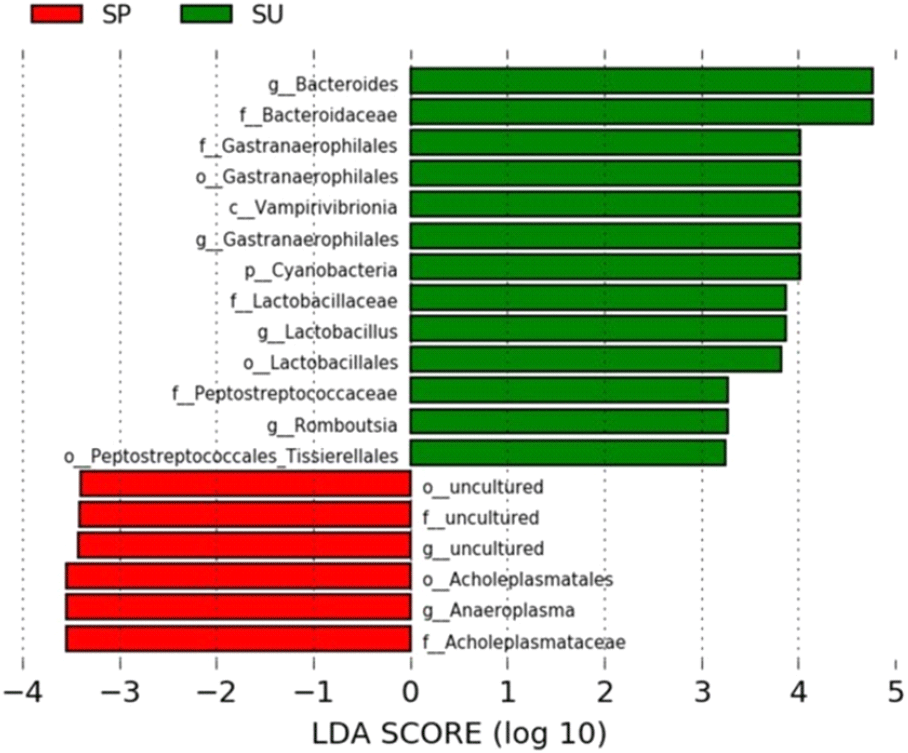
결론적으로 본 연구에서 일반 농가에서 여름철 고온 환경은 맹장 내 미생물 균총 구성의 차이를 유발하였지만 육계 체내에서 건강과 성장에 유익한 역할을 하는 미생물의 풍부도를 감소시켰다. 하지만, 복지 농가에서 사육된 육계는 일반 농가와 비교하여 이러한 차이가 상대적으로 적었다. 이러한 결과는 복지농가에서의 주거 환경 개선을 통한 스트레스 감소에 기인한 장내 미생물 균총 초기 정착에 영향을 받은 것으로 사료된다. 따라서, 본 연구 결과는 육계 농가의 고온 스트레스 관리와 주거 환경 개선이 수반되어야 한다는 점을 시사한다. 하지만, 일부 체내에서 유익한 역할을 하는 미생물이 여름철에 증가하는 경향을 보인 것은 고온 스트레스 이외의 요인들이 영향을 주었을 가능성을 나타내며, 이에 대한 명확한 기전을 규명하기 위해서는 추가 연구가 필요할 것으로 사료된다.








